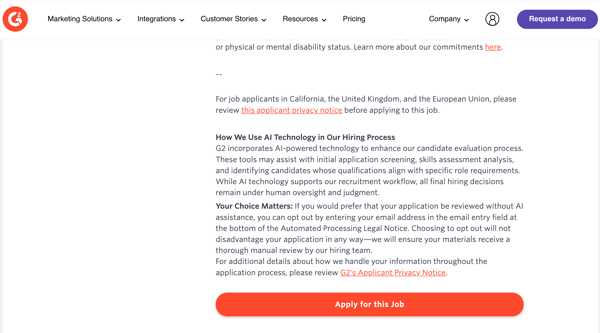October 3, 2025
 by Kelly Stone / October 3, 2025
by Kelly Stone / October 3, 2025

I’ve spent the past few months talking to recruiters, HR leaders, and staffing firm execs who are all saying the same thing: hiring looks nothing like it did even a year ago. Between the rise of AI-driven matching tools, evolving candidate expectations, and the continued tug-of-war over hybrid work, the staffing landscape is shifting faster than many teams can adapt.
But here’s the upside. These shifts are also creating opportunities for recruiters who know how to blend data, technology, and human connection. Whether you’re scaling a staffing agency, managing internal talent pipelines, or rethinking your hiring tech stack, staying ahead of these trends isn’t optional anymore; it’s strategic.
Let’s break down the top staffing industry trends shaping 2026. Understanding where the industry is headed will help you hire smarter and make the most of modern recruitment tools built for this new era of work.
If you’re leading a staffing firm, managing a recruiting team, or simply trying to fill roles faster in a tight market, these trends aren’t just background noise — they’re shaping how you compete, connect, and deliver results in 2026. Understanding them helps you hire smarter, build stronger client partnerships, and adapt your team’s workflow for long-term success.
Here’s what that looks like in practice:
All of this sets the stage for what’s next. The trends shaping 2026 will demand a balance of technology, strategy, and human connection — and the staffing leaders who can blend all three will have the biggest advantage.
Technological advancements and evolving economic conditions have heavily influenced the staffing and recruiting industry this year. While the demand for skilled talent grows, skills shortage remains a significant issue.
After several years of rapid shifts, the staffing industry is entering a period of normalization. The post-pandemic hiring surge has cooled, and economic uncertainty, cost pressures, and workforce restructuring have pushed firms to become more selective about where they grow.
Global staffing revenue is projected to reach $650 billion in 2025, with slower but steady expansion across specialized sectors such as IT, healthcare, and engineering. Instead of scaling aggressively, staffing firms are focusing on sustainable growth, niche expertise, and long-term client partnerships.
This recalibration is forcing a change in priorities. Recruiters are measuring success not just by the number of roles filled but by placement quality, retention rates, and client ROI. Firms are also refining operations to manage costs and improve efficiency through automation and analytics.
While the pace has leveled out, this moderation may actually benefit the industry, allowing firms to strengthen relationships, stabilize revenue, and build smarter, more resilient staffing models.
Amid this selective growth, technology is becoming the lever firms use to do more with less and artificial intelligence has moved from buzzword to backbone in the staffing world. In 2026, AI touches nearly every stage of the recruiting process, from sourcing and screening to outreach and onboarding. What used to take hours of manual searching and coordination now happens in minutes, thanks to intelligent matching algorithms and automated workflows.
According to a recent report, 88% of companies now use AI for their initial candidate screening in their recruitment process, and it’s paying off.
Early studies suggest that fully automated search and match systems could help recruiters reclaim almost a third of their week, saving around four to five hours on candidate sourcing and another three to four hours on screening and admin tasks. That’s time that can be redirected toward higher-impact work like candidate engagement.
Another study found that automated onboarding can increase candidate loyalty 30% to 45%.
By offloading repetitive tasks like resume parsing, initial outreach, and interview scheduling, recruiters are reclaiming valuable time to focus on strategy, storytelling, and relationship-building. Here’s how AI and automation are being used across the staffing journey:
| Recruitment stage | How AI and automation are used | Impact on recruiters and firms |
| Sourcing | AI-driven tools scan databases, social media, and job boards to identify top candidates automatically. | Faster sourcing and reduced manual research time. |
| Screening and matching | Algorithms analyze resumes and profiles to match candidates with job descriptions based on skills, experience, and fit. | Improves match quality and shortens the shortlist process. |
| Candidate outreach | Automated email or chatbot systems personalize outreach and follow-ups at scale. | Keeps candidates engaged and reduces communication gaps. |
| Interview scheduling | AI assistants coordinate calendars and handle rescheduling automatically. | Saves administrative time and minimizes scheduling conflicts. |
| Onboarding and compliance | Automation simplifies document collection, verification, and onboarding workflows. | Speeds up new hire readiness and reduces errors. |
| Talent analytics | Predictive analytics forecast hiring needs and identify patterns in candidate success | Enables data-driven hiring decisions and workforce planning. |
That shift is transforming the recruiter’s role. Instead of spending hours filtering resumes, they’re analyzing data, advising clients, and improving the overall candidate experience. A recent study notes that 73% of enterprises are planning to invest in AI-powered recruitment automation within the next 12 months.
The growing importance of AI in recruiting is also reflected on G2, where a new AI Recruiting Software category was officially launched in September 2025, underscoring how rapidly this technology is shaping the future of staffing.
The real opportunity lies in balance. Firms that combine AI’s precision with human empathy are seeing higher placement rates, happier candidates, and stronger client partnerships.
For example, being transparent with candidates about how AI is used during recruitment and giving them the choice to opt in or out of AI-driven steps helps build trust and fairness into the process. It’s an approach already being practiced at G2, where candidates are informed about the use of AI tools in recruiting and can choose whether they want AI assistance in their journey.

This kind of transparency sets the standard for responsible AI adoption in staffing, ensuring technology enhances the human experience, not replaces it.
Gut feeling used to drive most hiring decisions. In 2026, data does. Staffing firms are using analytics to forecast demand, measure recruiter performance, and improve placement accuracy, turning recruiting from an instinct-driven process into a measurable science.
Data is being applied across the staffing lifecycle, from identifying high-performing candidates to tracking time-to-fill, sourcing channels, and long-term client ROI. Some firms are even using AI-powered dashboards to predict which candidates are most likely to accept offers or which clients are at risk of churn.
| Where data makes an impact | Example |
| Candidate sourcing | Identify top-performing channels and optimize spend. |
| Client management | Forecast demand based on historical hiring patterns. |
| Recruiter performance | Measure productivity and conversion rates, quality of hire |
| Placement success | Track retention, satisfaction, and repeat placements. |
The most forward-thinking firms are even using predictive analytics to anticipate when candidates are likely to leave a role or when a client will ramp up hiring again, giving them a competitive edge in timing and personalization.
For recruiters, this shift means less manual tracking and more meaningful insight. Instead of reacting to hiring needs, data-driven staffing enables teams to predict them, turning recruiting into a proactive, strategic function.
In 2026, staffing firms are hiring for skills, not résumés, degrees, or previous job experiences. Employers are realizing that what candidates can do matters more than where they studied or worked.
A LinkedIn study found that removing degree requirements can expand candidate pools up to 19x, helping organizations hire more inclusively and efficiently.
For staffing firms, this trend is both an opportunity and a challenge. Recruiters need to become fluent in interpreting and validating skills data, especially as more candidates present nontraditional career paths, such as boot camps, freelance work, and project-based experience.
Firms that understand how to assess, verify, and place candidates based on their abilities will build deeper talent pipelines and deliver more consistent hiring success in 2026.
AI is no longer just for tech teams. It’s becoming a basic workplace skill. By 2026, even non-technical roles will need some level of comfort using AI tools to research, write, analyze, or automate tasks. Skills for AI-exposed jobs are changing 66% faster than for other roles, showing how quickly expectations are evolving.
And the payoff is clear.
Staffing firms are already adapting. Many now screen for AI familiarity during interviews and offer AI-readiness training to help candidates stay competitive. The goal isn’t to turn everyone into developers. It’s to ensure every worker knows how to work with AI, not around it.
The way we work, more specifically, where we work, has undergone a big shift in recent years. Remote and flexible work arrangements are now a permanent fixture in many companies. According to Upwork, more than one in five U.S. workers will be remote by 2025, reflecting a long-term shift in workplace dynamics. Here is how it has affected recruiting trends:
Candidates across industries are prioritizing flexibility in their job searches, seeking roles that offer remote or hybrid work arrangements. This shift in employee preferences has huge implications for staffing firms, which must adapt their strategies to attract qualified candidates. At the same time, the number of workers required to be in the office regularly has increased to 75% in late 2024, creating new challenges for staffing teams matching expectations on both sides.
Hybrid work models have emerged as the middle ground for many companies. They blend the benefits of remote work with the value of in-person collaboration.
Staffing firms are adapting by helping clients design hybrid hiring strategies that combine in-office collaboration with remote flexibility. They’re also expanding talent pools globally, using digital tools to manage compliance, payroll, and onboarding for distributed teams.
To support hybrid models effectively, staffing firms must:
For recruiters, this shift means redefining what “local talent” means. The best placements in 2026 are no longer bound by ZIP codes, they’re shaped by time zones, collaboration tools, and adaptability.
The rise of remote work parallels the growing influence of project-based work. Gig workers look for positions that afford them flexibility and the autonomy to take on multiple projects. This means there is a significant opportunity for recruiters to tap into a vast pool of skilled freelancers and contractors.
For recruiters, gig economy allows them to:
Employers benefit from gig workforces by reducing labor costs and securing specialized expertise without long-term commitments. To tap into this trend, staffing firms need to adapt their approaches to sourcing, managing, and retaining contingent talent.
The talent shortage has been a major challenge for staffing firms and recruiters, with 75% of employers reporting difficulties filling positions. And it doesn’t seem to be easing up in 2026, even as the job market fluctuates amid economic uncertainty, layoffs, and AI-driven restructuring.
The good news is that staffing firms can use several strategies to combat the shortage and access top talent. From myriad job sites and social media to networking events and employee referrals, there are more avenues than ever to discover the talent you need. Building a strong talent pool and promoting diversity and inclusion in hiring practices can help firms and businesses combat the skills shortage and be successful.
To overcome talent shortages in healthcare, for example, recruiters can:
These methods can help widen the pool of talent, especially since the U.S. is experiencing a severe shortage of healthcare workers at every level.
Apart from technical skills, businesses are placing value on soft skills, such as problem-solving, communication, teamwork, and empathy. These are human capabilities that AI cannot replicate.
Emotional intelligence is another key soft skill that sets top candidates apart. It’s not just about hiring people with technical proficiency but identifying those who can handle interpersonal relationships effectively.
Need another reason to focus on soft skills? According to research, hiring employees with more soft skills could increase revenue by more than $90,000.
Diversity brings a variety of perspectives and ideas to the table, which can lead to better decision-making and problem-solving. Companies with diverse hiring practices are more likely to experience above-average profitability. McKinsey & Company found that diverse teams outperform less diverse ones by up to 39%, underscoring the strong business case for prioritizing diversity, equity, and inclusion (DEI).
To promote DEI, staffing firms can adopt strategies such as:
Overall, as the job market recalibrates, the firms that thrive will be those that look beyond credentials — building inclusive, skill-diverse pipelines that can adapt to an uncertain economy.
In 2026, candidate experience is a business strategy, not just a courtesy. Every interaction, from job application to onboarding, shapes how talent perceives your brand. A poor experience can discourage top candidates, damage reputation, and make future recruiting even harder. Here are some key ways businesses can improve the candidate experience:
In today’s job market, generic job postings and impersonal communication simply don’t cut it. Candidates expect a personalized experience that shows the company understands their unique needs and goals.
Companies have turned to data analytics and AI to personalize every step of the hiring process. From tailored job recommendations to individualized communication and onboarding, personalization helps candidates feel valued and connected with the organization.
A company’s brand is no longer just about its logo or website. It’s a reflection of its culture, values, and employee experience. Putting more emphasis on showcasing a company’s unique selling points has helped firms attract candidates who align with the mission and vision. Employer branding involves using social media, company blogs, employee stories, and a positive work environment.
Candidates want clear information about salary, job responsibilities, and benefits early in the process. In fact, 82% of U.S. job seekers are more likely to apply for jobs that disclose pay ranges upfront. Firms that embrace pay transparency are better positioned to build trust and attract top talent.
On the same line, candidates expect prompt and clear communication throughout the recruitment process. This includes:
Even if a candidate is not selected, timely and thoughtful feedback can leave a lasting positive impression.
A positive onboarding experience sets the tone for an employee’s tenure. A great way to do this is to invest in structured onboarding programs that welcome new hires, provide necessary training, and facilitate integration into the company culture.
A successful onboarding process helps new employees feel valued, supported, and equipped to succeed. Starting out in such an organized and positive way can increase an employee’s satisfaction with their job and with the company in the long run.
Recruiters put a lot of time and effort into finding great candidates, but unless relationships are established and cultivated, candidates will seek other jobs. In 2024, a major trend emerged: creating work environments that not only attract but also retain skilled professionals.
Here are key strategies to help you do the same:
Staffing firms that invest in their employees’ growth and development are more likely to retain top talent. Offering clear career paths, mentorship programs, and opportunities for career development can significantly boost employee satisfaction and loyalty. By providing a sense of direction and purpose, staffing firms can help employees feel valued and motivated to stay.
New technology is being developed constantly, and continuous learning is essential for staying competitive. Doug Hammond of Randstad Inhouse Services emphasizes that upskilling allows companies to create the workforce that you need. It goes a long way to solving the skills shortage.
You can motivate and empower employees by providing:
These initiatives benefit both employees and the organization, creating a win-win scenario that promotes loyalty and long-term success.
Employee engagement plays a crucial role in retention. Staffing firms that prioritize creating a positive work environment and fostering strong employee relationships can significantly reduce turnover. This can involve implementing initiatives such as:
After several years of rapid tech adoption, staffing firms are realizing that more tools don’t always mean better performance. Between 2020 and 2025, many teams layered multiple point solutions — one for sourcing, one for ATS, another for onboarding, another for analytics — creating complexity and data silos. In 2026, the focus has shifted toward streamlined, integrated systems that connect every part of the staffing workflow.
Firms are consolidating their tech stacks into unified talent platforms that combine CRM, ATS, and analytics capabilities in one place. This integration improves visibility across the candidate and client lifecycle, reduces manual data entry, and helps recruiters move faster with better insights.
On G2, this shift is reflected in the rise of integrated talent management and recruitment platforms, where users increasingly favor all-in-one systems that connect sourcing, onboarding, and analytics tools under one ecosystem. Reviews highlight that teams gain the most value not from the number of tools they use, but from how seamlessly those tools work together.
As the industry matures, the goal isn’t just to add new technology; it’s to make existing tools work together seamlessly. The staffing firms leading in 2026 aren’t defined by how much tech they have, but by how well it’s connected.
With so much change ahead, the question is how can recruiters stay ahead of it all? To stay relevant and resilient, recruiters need to think beyond hiring and start leading with strategy, foresight, and adaptability.
The recruiters who thrive in 2026 won’t be the ones who chase trends but those who interpret them, act early, and lead with trust and expertise.
The staffing industry is entering a new era defined by agility, technology, and human connection. Outdated playbooks won’t keep firms competitive in 2026.
To thrive, recruiters and staffing leaders need to prioritize the candidate experience, embrace integrated, data-driven technology, and focus on long-term relationship-building rather than quick wins. The firms that combine innovation with empathy will attract stronger talent, retain clients, and build trust in an unpredictable market.
Adapting to these changes isn’t always easy, but staying informed is the first step toward a more resilient, future-ready strategy. Those who evolve with these shifts won’t just keep pace with the industry — they’ll shape what staffing success looks like in the years ahead.
Don’t get left behind. Explore how AI is reshaping recruitment.
Edited by Monishka Agrawal
This article was first published in 2024 and has been updated with new information.
Kelly Stone is the Content Marketing Manager at Ceipal, the global leader in AI-powered staffing, recruiting, and talent software. She produces content for demand creation and manages editorial processes and the company’s website.
The shift to a candidate-driven market is the most extensive and significant development in...
 by Preethi Varma
by Preethi Varma
We’ve always heard that robots will take over our jobs.
 by Nivedita Joshi
by Nivedita Joshi
Did you know the average time recruiters take to scan your resume is six seconds?
 by Braja Deepon Roy
by Braja Deepon Roy
The shift to a candidate-driven market is the most extensive and significant development in...
 by Preethi Varma
by Preethi Varma
We’ve always heard that robots will take over our jobs.
 by Nivedita Joshi
by Nivedita Joshi


